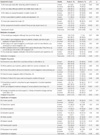Abstract
Purpose
The purpose of this study was to compare and check the levels of cancer pain management knowledge and awareness between doctors and nurses in a tertiary hospital and to develop an intervention program.
Methods
Participants were 725 nurses and 95 doctors working in a hospital from May 2 to 29, 2009. Data were analyzed using t-tests, χ2-tests, and ANOVA with SPSS WIN 18.0.
Results
In a comparison of the pain management score, nurses showed significant results for age (p<.001), carrier (p<.001), education (p<.001), workplace (p<.001), and doctors showed significant results only for age (p=.032). Doctors' marks were significantly higher than nurses' in pain management scores (p<.001). Knowledge about analgesic medication (t=-5.38, p<.001) and analgesic drug effect (t=-8.59, p<.001) were significantly different in the pain management subcategory score between nurses and doctors. There were four items with different awareness levels related to analgesics between nurses and doctors.
Figures and Tables
References
1. Korea National Statistics Office. Annual report on the causes of death statistics 2008. accessed on 1 April 2009. Seoul: Available at: http://kosis.kr/abroad/abroad_01List.jsp.
2. Paice JA. Yarbro CH, Frogge MH, Goodman M, editors. Pain. Cancer Symptom Management. 2004. 3rd ed. Massachusetts: Jones and Bartlett Publishers;77.
3. Han KJ, Lee EO, Kim MJ, Park YS, Hah YS, Song MS, et al. Cancer patients' needs when chemotherapy ends. J Korean Oncol Nurs. 2005. 5:107–115.
4. Kim SO. The plan for systematic improvement in using a narcotic drug to reduce pain for cancer patient in terminal stage [dissertation]. 2006. Seoul: Yonsei Univ.
6. Gong SW, Ban JY, Seo MS, Hyun SS, Kim HJ, Lee MA, et al. Knowledge and attitudes of oncology nurses toward cancer pain managements. J Korean Acad Adult Nurs. 2004. 16:5–16.
7. National Cancer Information Center. Cancer pain management guideline. accessed on 1 March 2009. 3rd ed. Avaliable at; http://www.cancer.go.kr/ncic/cics_t/01/011/index.html.
8. Korea Health Industry Development Institute. Guidelines for hospital evaluation programme. 2007. Seoul: Ministry Health and welfare press.
9. Park HA, Koh MJ, Lee HS, Kim YM, Kim MS. Nurses' knowledge about and attitude toward cancer pain management: a survey from korean cancer pain management project. J Korean Acad Adult Nurs. 2003. 15:205–214.
10. Kim MR. Knowledge about cancer pain management of clinical nurses [dissertation]. 2008. Seoul: Catholic Univ..
11. Hwang KO. Clinical nurses' knowledge and practice on nursing intervention to relieve the pain of patients with cancer [dissertation]. 2006. Seoul: Korea Univ..
12. Kim HK, Lee HS, Hwang KH, Yoo YS, Lee SM. Positive and negative determinants for pain management in both cancer patients and their nurses. J Korean Acad Fundam Nurs. 2006. 13:68–75.
13. Kang SG. A study on the nurses' knowledge regarding pain and their pain interventions [dissertation]. 2007. Seoul: Chung-Ang Univ..
14. Uhm SY. A study on the knowledge of pain and the pain intervention of clinical nurses [dissertation]. 2007. Gongju: Kong Ju National Univ..
15. Jun MH, Park KS, Gong SH, Lee SH, Kim YH, Choi JS. Knowledge and attitude toward cancer pain management:clinical nurses versus doctors. J Korean Acad Soc Nurs Educ. 2006. 12:115–123.
16. Choi SY. Pain management and pain knowledge of nurses. J Korean Oncol Nurs. 2004. 4:82–90.
17. Lee HY, Lee YO, Choi EY, Park YM. A comparison on stress and coping of bereavement care between nurses in the cancer unit and nurses in the general unit. J Korean Oncol Nurs. 2007. 7:26–35.
18. Lee SH. Knowledge and attitudes of clinical nurses and doctors toward cancer pain management. [dissertation]. 2003. Daejeon: Daejeon Univ..
19. Jung KI, Park JS, Kim HO, Yoon MO, Moon MY. A survey of nurses' and doctors' knowledge toward cancer pain management. J Korean Clin Nurs Res. 2004. 10:111–124.
20. Mun JH. The comparison of physicia's and nurse's knowledge and attitudes toward pain management [dissertation]. 2011. Daegu: Kyungpook National Univ..
21. Park YS, Shin YH. Nurses' knowledge on pain management. Korean J Adult Nurs. 1995. 6:299–307.
22. Kim SJ, Hong EH, Sung LN, Kim ES, Hing EH, Yeum MR, et al. Effects of a systemic pain management method used by a group of nurses on pain management of oncology patients. J Korean Acad Adult Nurs. 1997. 9:148–161.




 PDF
PDF ePub
ePub Citation
Citation Print
Print







 XML Download
XML Download